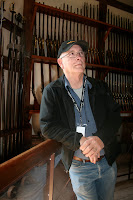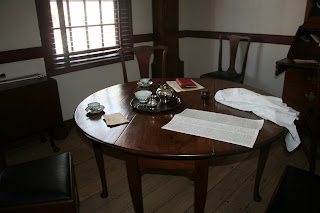This morning we went for breakfast at The Astronomical House of Pancakes. Let me tell you these pancakes are HUGE!!! Kevin and I should have split an order of them and the country ham instead of each getting our own. They filled the entire plate. This may very well be the first time he hasn't finished his pancakes...lol.
After breakfast we headed over to Colonial Williamsburg. I had forgotten our Annual Passes we got when we were here in October of last year, so we had to pay $5 each for new ones. We choose to wall down to the historic area rather than take the shuttle to help wear off our breakfast.
Our first stop was at Bruton Parish Church. There was no separation of church and state in Colonial Williamsburg. The Church of England was the official religion for the colony, and as the Anglican church in the capitol, Bruton Parish Church was probably the most important church in Virginia. All around the church were grave markers and raised cement graves from the 1700's. One of the was the daughter of President John Tyler. At one spot they had placed a bench between two of the headstones as though they were the ends of the bench.
Bruton Parish Church |
 |
Memorial for President John Tyler's daughter |
We made a stop at the outdoor market where we got a new pair of stockings for Kevin's colonial outfit, and a bag of Pieces of Eight. During the colonial period, foreign coins from Spain, England, Holland, Portugal, France, and other places were used in the colonies. By far the most commonly circulated coin in the Virginia colony was the peso, or Spanish milled dollar. The patterned milled edge of he coin was designed to prevent dishonest people from shaving silver from the edge unnoticed.





| ||
In the eighteenth century gold and silver were valued by their weight. Thus, coins could be divided into pieces without losing any of their value. By dividing a coin, such as aSpanish milled dollar, the bearer could spend part of the coin in one place and use the rest of the pieces to pay another debt. The Spanish dollar could be divided into halves, quarters, and eights. When divided into eights, the sections were called "pieces of eight" or "bits" -hence the slang "two bits" to mean a quarter of a dollar. When the new American nation established its own coinage in 1792, it was this coin that became the basis for the American dollar. I got a bag og pieces of eight that were reproduced from a whole 1757 Spanish milled dollar in the collections of the Colonial Williamsburg Foundation. They were cast in lead-free pewter.
Next stop was the Magazine and Guardhouse.
Magazine |
Guard House |
The Magazine served as the arsenal for the Virginia colony. Here you can see authentic firearms and military equipment displayed and listen as armorers and guards tell the story of British and American military forces in Virginia from the French and Indian War to the War for American Independence. Here the interpreter spoke of a book called The Diary of the American War by E. Wald.
Next to some shops, at Tarpleys Store I got three balls of soap that are handmade here in Colonial Williamsburg. They were Peppermint, Lavendar, and Magnolia.




Then at the Post Office and Printer, which we visited on a Ghost tour when here last October, I got a Guide book on Colonial Williamsburg and some Virginia paper money. It has been photographically reproduced from examples in the Colonial Williamsburg Collection. They range in date from 1759-1781 and in value from two pounds to two hundred dollars. Virginia was the last of the thirteen colonies to issue paper money, properly called "treasury notes".
Then at the Golden Ball, represents the shop of James Craig a jeweler who arrived from London in 1745. He like most jewelers did not just deal in jewelry, but also repaired household silver items. He also employed an engraver and watchmaker. It was here that I got some jewelry... couldn't pass up the opportunity and besides I have gotten some little something in every store we've been in, couldn't break my stride...lol.
 |
| Jewelry from Golden Ball |
What I got was a necklace and earring set called clockface jewelry. They were designed from a clock in the Williamsburg Collection. From the area where scroll work and fabric cover the chimes.
Our last stop for the day was Wetherburn's Tavern. Here in this original building they focus on Henry Wetherburn, his family, and his slaves, who made Wetherburn's Tavern one of the most successful of the 1750's. The outbuildings behind Wetherburn's form a domestic production area essential to the operation of a busy colonial tavern.
 |
| Office |
 |
| Shaving Cuff |
 |
| Dining Room |
 |
| Spinning Wheel |
Flowers along the path to Colonial Williamsburg |
Red Bud Tree |












No comments:
Post a Comment